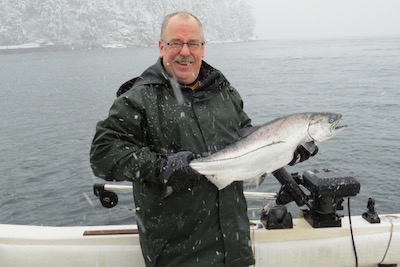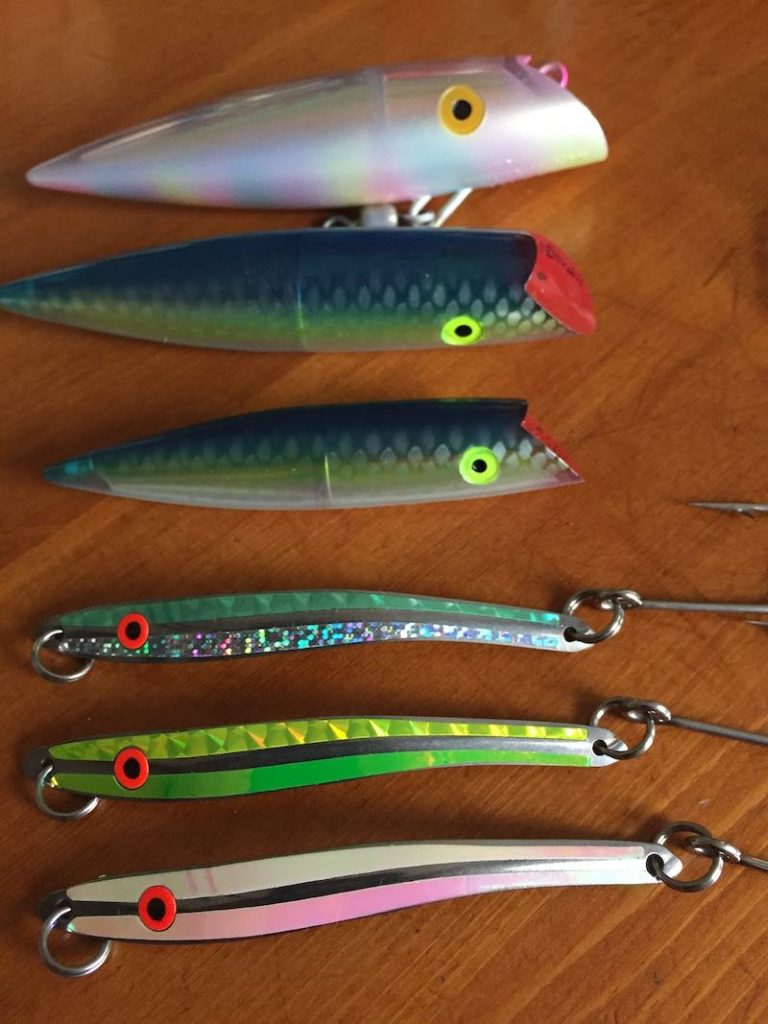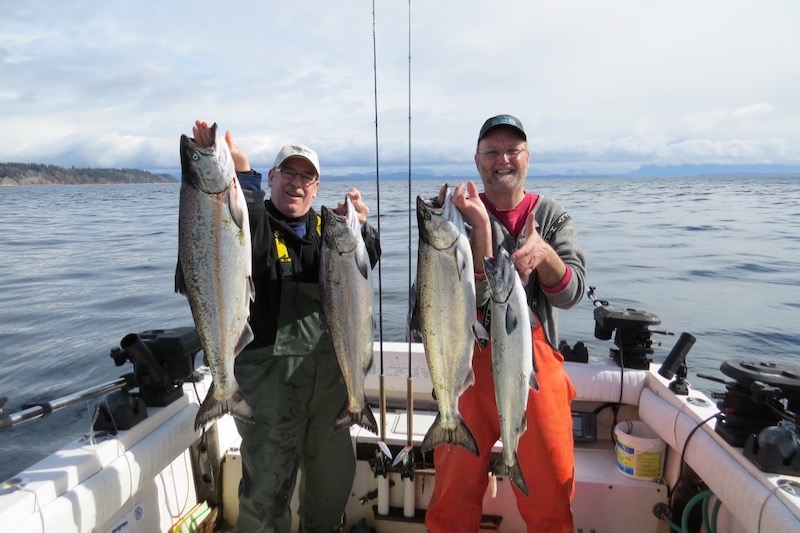
by Jeremy Maynard
One of the great features of salmon fishing on the BC coast is that anglers fish for them 365 days a year, subject to local time and area restrictions. Of course, this opportunity only applies to Chinook salmon, as the other species are either still way out in the open ocean or too small to be legal quarry outside the traditional summer season. Thanks to the multi-year coastal rearing life history of many Chinook stocks, productive fishing for them can be had right through the winter months.
While all the usual techniques employed in the summer Chinook fishery will work in the winter, often there are small differences in both tactics and locations that can increase success between November and April. One important aspect of this seasonal fishery is that the target fish are almost all immature, the search for food dictating their movements rather than migration towards their home rivers driven by the onset of maturity. This also means that the average size of the Chinook salmon encountered in the winter are smaller than in the summer, although anglers should always be prepared to deal with the occasional larger-than-usual fish.
The hunt for feeder Chinook can be framed as “the what and the where”—what they are eating or expect to be eating, and where their food source is or is expected to be. One feature of this fishery is that because we are in pursuit of actively feeding fish, the trolling speed is generally faster than during the summer, enabling the angler to cover more territory. I’m sometimes asked how fast I troll—my answer is I don’t have a target speed over ground but judge the relative speed of the boat by the angle on my downrigger cables.
When fishing with lures, which is most of the time, I want to know they’re out behind the cable actively working. I frequently troll fast enough to have a 30-degree angle on the downrigger cables, sometimes more. After an unproductive time, many anglers have experienced fish hitting a lure as the boat has sped up for some reason or as the gear is retrieved to check it, often a clue that the normal trolling speed is too slow. Most of my winter fishing takes place near Campbell River, where tidal currents are a fact of life. Chinook fishing is almost always more productive trolling with the current, enabling you to both cover more territory to find the fish and/or schools of bait and to make a better presentation—what crippled baitfish ever held position against the current?
Feeder Chinook are omnivorous, meaning they’ll eat just about anything. A better understanding of this is being developed by Will Duguid, a PhD student at the University of Victoria conducting a survey on the stomach contents of Chinook and coho salmon. A description of this interesting project is outside the scope of this article, but it is evermore clear that a hungry Chinook salmon will eat anything it can wrap its mouth around. That said, for the highest prospects of success the lures or baits used should best replicate the food source most likely to be encountered by the Chinook. That’s either herring or sand lance, followed to a lesser extent by anchovies, lanternfish, or squid depending on location.
Paired with a local bait-appropriate size and pattern of hoochie, the standard flasher and hoochie setup will work well for winter Chinook fishing. Leader length is generally a little shorter (36″ to 42″) than that used in the summer, imparting more action to the hoochie, especially with a faster-than-average trolling speed. With the water usually being clear in the winter, one school of thought maintains that having too much flash can put fish off. I think there’s something to this, and my usual flasher at this time of year is a light green-edged version with a bronze finish. In recent years I’ve also been experimenting with the so-called “sporty” flashers, using a shorter leader for the lures behind.
As a personal preference, I usually fish without a flasher on the line in the winter. Don’t get me wrong: I’m no purist, and I’d rather catch a Chinook with a flasher than not catch one without. That said, in this fishery I have a lot of confidence using plugs and spoons I can fish without a flasher on the line, although I always use a teaser or dummy flasher attached to the cannonball—it’s a big ocean and the extra attraction value these provide is an essential part of my gear. Playing a salmon without a flasher on the line is simply a more enjoyable experience, all the more so if the fish being caught are of modest size, which is often the case during the winter months.
When using plugs for Chinook fishing, I almost always use those made by Tomic Lures, the local favourite. Over the years I’ve built up quite a collection of different sizes, finishes, and colour patterns, but since the introduction several years ago of the “uvbii” line, most now sit unused. The acronym stands for UV body, iridescent insert, sometimes followed by an “rt” for red tail. I’m not so fussed about that, but in general the uvbii plugs simply out-produce all other plugs, and based on what I see being used in other boats, many Campbell River guides and anglers agree.
The plugs are available in lengths between 3″ and 7″; choose a size and colour pattern that best matches the bait size that the Chinook you’re after expect to encounter. Because adult herring is the most common prey in my home waters, the standard 5″ Tomic plug is my go-to in the winter, but for contrast on the second line I often fish a Tubby version of the same or a standard 6″. If the bait around is smaller, I’ll fish a Tubby 4″ plug or a standard 4″ version, but one thing to be said for using larger lures is that they lower the encounter rate of sub-legal Chinook, an important consideration if they are prevalent. Available in all the usual Tomic patterns like the #602 or #700, I’ve come to really like the new #645 uvbii “Herring Aid.” If lanternfish show up in the stomachs of Chinook when cleaning them, I’ll try a 4″ #512 uvbii next time out; the black herring scale back is an excellent representation of these deepwater baitfish. Because I think plugs work better on a longer lead, I usually fish them about 15 to 20 ft/5 to 7 m back from the release clip. This allows them to really work from side to side, especially when I’m trolling at my usual faster speed.
In areas where sand lance (a.k.a. needlefish) are the dominant baitfish, spoons and hoochies become the lures of choice, and the selection is considerable. One welcome development in recent years is the production of high-quality spoons on Vancouver Island—both AP Tackleworks and Peetz make durable spoons in a variety of sizes and patterns that have quickly developed reputations for being highly attractive to feeder Chinook. As with plugs, spoons can be fished without a flasher on the line but because they don’t have a side-to-side motion, I fish them on a shorter lead back from the release clip, about 6 ft/2 m in length. When very small bait is prevalent, I use a small, trout-size spoon behind a mini-flasher on a 30″ leader. The smaller flasher provides some attraction value but doesn’t have nearly the drag of a standard flasher, giving the relatively small hook a better chance of remaining attached to a salmon.
Most winter Chinook fishing is done with lures, but using bait can be effective, especially as dogfish are largely absent at this time of year. Some anglers like to use anchovies or smaller herring rigged in teaser heads, and these can be used exactly as one would fish with spoons. At times and places where adult herring are prevalent, another choice is to fish with cut-plugged herring, especially if the Chinook around are larger than the average size for the season. Because of the relative fragility of the bait on the hooks, when fishing this way I troll more slowly than usual, attaching the line less firmly in the release clip so that it comes free without the salmon tearing the cut-plug off the hooks. Once again I use a dummy flasher attached to the cannonball for the attraction factor. If you expect the Chinook to be shallower (say, less than 120 ft/40 m) then this old-school style of fishing is a lot of fun and can be highly productive on the right day.
Fishing depth is often a crucial factor to success in this fishery, and there’s no question that a lot of winter Chinook fishing takes place on or near the bottom, especially in places where sand lance are the dominant baitfish. Not only do they spend much of their lives on the bottom, but the gravel and sand habitat they prefer allows anglers to fish their gear on or adjacent to the bottom without fear of hanging up. That’s not the case with rocky bottoms, so your gear has to be fished close to the bottom without being too close, lest disaster strike. If too close to the bottom, there’s also the consequence of encountering rockfish or lingcod, both out of season in the winter. There’s nothing so frustrating when checking a line after an unproductive period of time as discovering a small rockfish on the line—being dragged around doesn’t do anything positive for these fish and eliminates any chance you’ll hook a Chinook on the lure.
It goes without saying that boating in the winter deserves careful consideration of the weather. Ensure your boat is in top operating condition, dress warm, and pay attention to the marine weather forecast. Wind can eliminate or compromise opportunity, especially with southeasters in the Strait of Georgia or outflow winds in the inlets like Howe Sound. These factors taken into consideration, you can enjoy some excellent Chinook fishing on the BC coast in the winter months, with the added bonus that these fish are likely the tastiest to be had anywhere.
One Comment
Leave A Comment
Visit the Store
$34.99
$34.99
Featured Catch

Joel Unickow halibut (Photo: Rob Frawley Lucky Strike Sportfishing Tofino)











Hi Jeremy,
Can you please tell me what their feeding times happen to be, if known to you? I am a researcher, and it would help my project to know what time of day Chinook salmon usually feed.
I really appreciate it.
Thanks,
Maryam